3-4. Thus the Pleiades were associated with '400 youths', and we could
therefore count 135 (May 15) - 35 (February 4) = 100 or we could
count 500 (365 + 135) - 400 = 100.
|
Febr 4 |
35 |
+ 365 = |
400 |
|
May 15 |
135 |
500 |
In February 4 (400) the Full Moon would ideally reach the right
ascension line connecting up to Dramasa, the south pole star:
... Far away, the Mangaians of old
(Austral Islands, Polynesia), who kept the precessional
clock running instead of switching over to 'signs', claim
that only at the evening of the solstitial days can spirits
enter heaven, the inhabitants of the northern parts of the
island at one solstice, the dwellers in the south at the
other ...
400 (Dramasa) - 355 (December solstice) = 45.
|
Al Sa’d al Bula'-21 (Good Fortune of the
Swallower)
/
Dhanishta-24 (Most Famous)
/
Girl-10 (Bat)
YUE
(Battle-Axe) = ψ
Capricorni
(314.3),
GIENAH CYGNI =
ε
Cygni,
η
Cephei (314.5),
γ
Delphini (314.6),
σ
Pavonis (314.7),
ALBALI =
ε
Aquarii
(314.8)
BETELGEUZE (α
Orionis) |
BATEN ALGIEDI (Belly of the Goat) =
ω
Capricorni
(315.8) |
μ
Aquarii (316.0) |
ε
Equulei (317.8) |
No
star listed (318) |
21h (319.6)
ARMUS =
η
Capricorni
(319.0),
DORSUM =
θ
Capricorni
(319.3),
TSOO = 24 Capricorni
(319.7) |
DRAMASA =
σ
Oct.,
χ
Capricorni (320.0),
ν
Aquarii (320.3),
γ
Equulei (320.6),
ο
Pavonis (320.8) |
 |
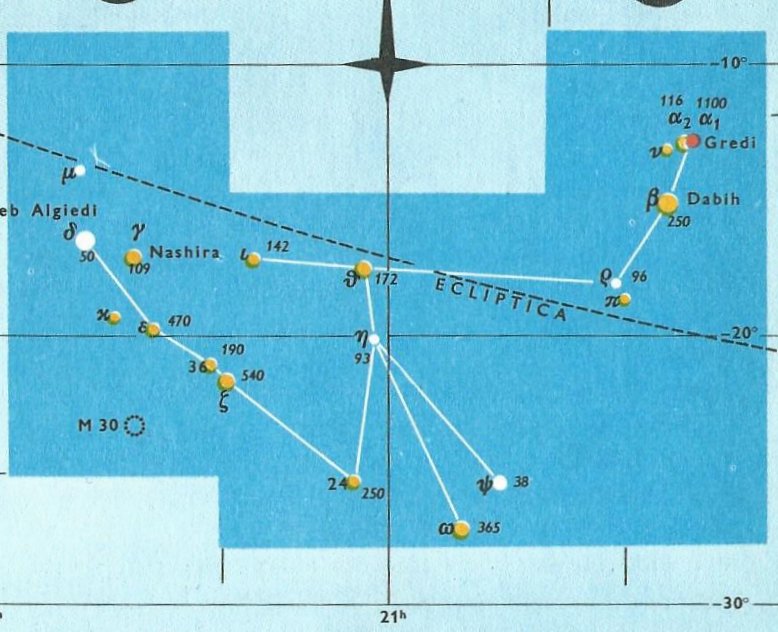 |
| Jan
29 |
30 |
31
(396) |
Febr 1 (32) |
2 |
3 |
4 (400) |
|
... The Sacred Book of the ancient
Maya Quiche, the famous Popol Vuh (the Book of Counsel) tells of
Zipacna, son of Vucub-Caquix (= Seven Arata). He sees 400 youths
dragging a huge log that they want as a ridgepole for their house.
Zipacna alone carries the tree without effort to the spot where a hole
has been dug for the post to support the ridgepole. The youths, jealous
and afraid, try to kill Zipacna by crushing him in the hole, but he
escapes and brings down the house on their heads. They are removed to
the sky, in a 'group', and the Pleiades are called after them ... |
 |
 |
 |
 |
 |
 |
 |
|
Ea3-12
(77) |
Ea3-13 |
Ea3-14 →
π |
Ea3-15
(80) |
Ea3-16 |
Ea3-17 |
Ea3-18 |
| tagata mau toki |
ko te vae |
toki |
henua |
toki |
kiore - hokohuki |
kiore tupu |
|
... In China, with Capricornus,
Pisces, and a part of Sagittarius, it [Aquarius] constituted the early
Serpent, or Turtle, Tien Yuen; and later was known as Hiuen
Ying, the Dark Warrior and Hero, or Darkly Flourishing One, the
Hiuen Wu, or Hiuen Heaou, of the Han dynasty,
which Dupuis gave as Hiven Mao. It was a symbol of the emperor
Tchoun Hin, in whose reign was a great deluge; but after the Jesuits
came in it became Paou Ping, the Precious Vase. It contained
three of the sieu, and headed the list of zodiac signs as the Rat,
which in the far East was the ideograph for 'water', and still so
remains in the almanacs of Central Asia, Cochin China, and Japan
...

Tupu. 1.
Shoot, sprout, bud; to sprout, to bud. 2. Pregnant: vî'e tupu (o te
poki); to be conceived (of fetus in its mother's womb): he-tupu
te poki i roto i te kopú o toona matu'a. Vanaga. To grow, to sprout,
to germinate, to come forth, to conceive, pregnant, germ; mea tupu,
plant; tupu ke avai, of rapid growth; tupu horahorau,
precocious; hakatupu, to produce, to stimulate growth, to excite.
P Pau.: fakatupu, to raise up, to create. Mgv.: tupu, to
grow, to conceive, to be pregnant. Mq.: tupu, to grow, to sprout,
to conceive. Ta.: tupu, to grow, to sprout. Churchill. Mgv.:
Tupu, the best or worst, used of men or of bad qualities. Sa.:
tupu, king. Ma.: tupu, social position, dignity. Churchill.
... Another year passed, and a man by the name of
Ure Honu went to work in his banana plantation. He went and came to
the last part, to the 'head' (i.e., the upper part of the banana
plantation), to the end of the banana plantation. The sun was standing
just right for Ure Honu to clean out the weeds from the banana
plantation. On the first day he hoed the weeds. That went on all day,
and then evening came. Suddenly a rat came from the middle of the banana
plantation. Ure Honu saw it and ran after it. But it disappeared
and he could not catch it. On the second day
of hoeing, the same thing happened with the rat. It ran away, and he
could not catch it. On the third day, he reached the 'head' of the
bananas and finished the work in the plantation. Again the rat ran away,
and Ure Honu followed it. It ran and slipped into the hole of a
stone. He poked after it, lifted up the stone, and saw that the skull
was (in the hole) of the stone. (The rat was) a spirit of the skull (he
kuhane o te puoko). Ure Honu was amazed and said, 'How
beautiful you are! In the head of the new bananas is a skull, painted
with yellow root and with a strip of barkcloth around it.' Ure Honu
stayed for a while, (then) he went away and covered the roof of his
house in Vai Matā. It was a new house. He took the very large
skull, which he had found at the head of the banana plantation, and hung
it up in the new house. He tied it up in the framework of the roof (hahanga)
and left it hanging there ... |
|
γ
Pyxidis (133.6) |
ζ
Hydrae (134.1),
ρ
Cancri (134.2),
ζ
Oct.
(134.3), ο Cancri (134.6), δ Pyxidis (134.9) |
ACUBENS
= α Cancri,
TALITHA BOREALIS = ι Ursae Majoris
(135.0),
σ Cancri (135.2), ρ Ursa Majoris (135.6) |
ν Cancri
(136.0),
TALITHA
AUSTRALIS = κ Ursae Majoris
(136.1),
ω Hydrae (136.8) |
9h (137.0)
σ¹ Ursa Majoris (137.0), κ Cancri (137.3),
τ Cancri (137.4),
ALSUHAIL (al Wazn, of the
Weight) = λ Velorum
(137.5), σ² Ursa Majoris (137.6), τ Ursa Majoris (137.7), ξ Cancri
(137.8)
*96.0 = *137.4 - *41.4 |
κ
Pyxidis (138.0), ε Pyxidis (138.5) |
π
Cancri (139.2),
MIAPLACIDUS =
β
Carinae
(139.3),
TUREIS (Little Shield) =
ι
Carinae
(139.8) |
 |
|
July 31 (212) |
Aug
1 |
2
(314 - 100) |
3
(580 = 397 + 183) |
4 (2 * 108) |
5 |
6
(139 + 79) |
|
... It was 4 August 1968, and it was
the feast day of Saint Dominic, patron of Santo Domingo Pueblo,
southwest of Santa Fe. At one end of the hot, dusty plaza, a Dominican
priest watched nervously as several hundred dancers arranged in two long
rows pounded the earth with their moccasined feet as a mighty,
collective prayer [ui] for rain, accompanied by the powerful
baritone singing of a chorus and the beat of drums. As my family and I
viewed this, the largest and in some ways the most impressive Native
American public ceremony, a tiny cloud over the Jémez Mountains to the
northwest got larger and larger, eventually filling up the sky; at last
the storm broke, and the sky was crisscrossed by lightning and the
pueblo resounded with peals of rolling thunder ... |
And counted from Alcyone (May 16, 136) to the
last day in January (396) there were 260 (→
9 * 29 - 1) days. This
number could be reflected in the Mayan
Tzolkin:
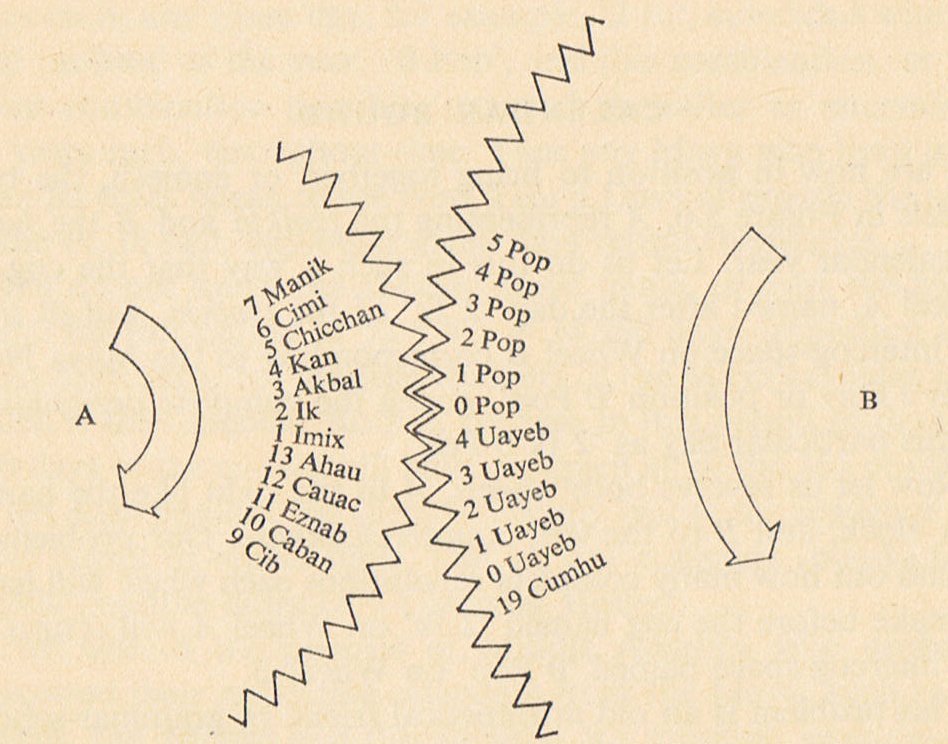
|
α Oct. (321.5), δ
Equulei (321.7),
φ
Capricorni (321.8) |
KITALPHA (Part of a Horse) =
α
Equulei
(322.0),
ALDERAMIN (The Right Arm) =
α
Cephei
(322.9) |
DAI =
ι
Capricorni
(323.5),
β
Equulei (323.8) |
γ
Pavonis (324.1),
YAN =
ζ
Capricorni
(324.6) |
Al Sa'd al Su'ud-22
(Luckiest of the Lucky)
/
Emptiness-11 (Rat)
TSIN = 36 Capricorni
(325.2),
ALPHIRK (The Flock) =
β
Cephei
(325.7),
SADALSUD =
β
Aquarii,
ξ
Gruis (325.9) |
No star listed (326) |
CASTRA =
ε
Capricorni
(327.2),
BUNDA (Foundation) =
ξ
Aquarii
(327.5)
SIRIUS (α Canis Majoris) |
Mahar sha hi-na Shahū-26
(Western One in the Tail of the Goat)
NASHIRA (Fortunate One) =
γ
Capricorni
(328.0),
ν
Oct. (328.3),
AZELFAFAGE (Horse's Foot Track) =
π¹
Cygni,
κ
Capricorni (328.7) |
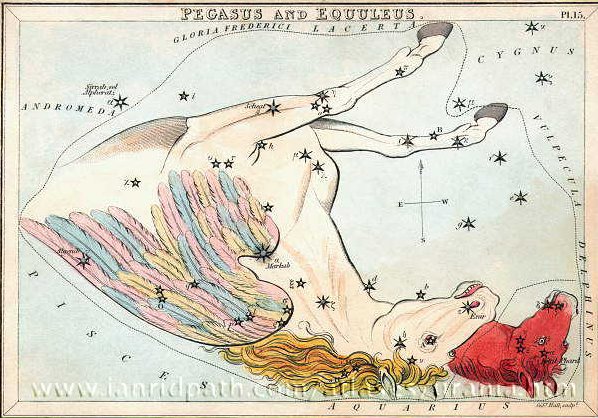 |
|
Febr 5 (36) |
6 |
7 |
8 (404) |
9 (40) |
10 |
11 |
12 (408) |
|
... On February 9 the Chorti Ah K'in,
'diviners', begin the agricultural year. Both the
260-day cycle and the solar year are used in setting
dates for religious and agricultural ceremonies,
especially when those rituals fall at the same time
in both calendars. The ceremony begins when the
diviners go to a sacred spring where they choose
five stones with the proper shape and color. These
stones will mark the five positions of the sacred
cosmogram created by the ritual. When the stones are
brought back to the ceremonial house, two diviners
start the ritual by placing the stones on a table in
a careful pattern that reproduces the schematic of
the universe. At the same time, helpers under the
table replace last year's diagram with the new one.
They believe that by placing the cosmic diagram
under the base of God at the center of the world
they demonstrate that God dominates the universe.
The priests place the stones in a very particular
order. First the stone that corresponds to the sun
in the eastern, sunrise position of summer solstice
is set down; then the stone corresponding to the
western, sunset position of the same solstice. This
is followed by stones representing the western,
sunset position of the winter solstice, then its
eastern, sunrise position. Together these four
stones form a square. They sit at the four corners
of the square just as we saw in the Creation story
from the Classic period and in the Popol Vuh.
Finally, the center stone is placed to form the
ancient five-point sign
modern researchers called the quincunx ...
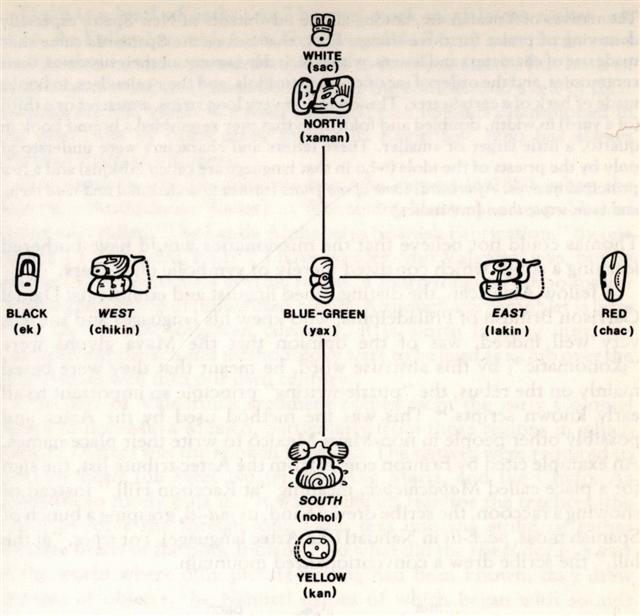
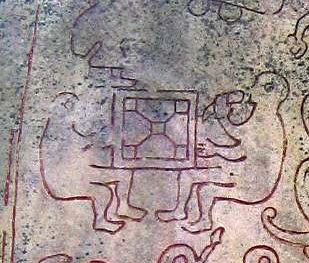 |
 |
 |
 |
 |
 |
 |
 |
 |
|
Ea3-19
(84) |
Ea3-20 |
Ea3-21 |
Ea3-22 |
Ea3-23
(88) |
Ea3-24 |
Ea3-25 |
Ea3-26 |
| tagata
rere toki |
manu puo
pouo |
toki |
mauga |
toki i te henua ku tutu
raua |
marama |
marama |
|
Tutu, 1. Circle of fishing nets arranged
in the shape of a funnels or baskets. 2. To light a
fire; he-tutu i te ahi: to burn something. 3.
To hit, to strike, to beat. Tûtú, to shake
(something) clean of dust or dirt; he-tûtú te
oone o te nua, to shake the dirt off a nua
cape. Tutuhi, to reject the responsibility
for a mistake onto one another, to blame one another
for a mistake (see tuhi). Tutuki, to
stumble, to trip. O tutuki te va'e, in order
not to trip. Tutuma, firebrand, partly burnt
stick. Tuturi, to kneel. Vanaga. 1. To beat
bark for cloth. PS Pau., Mgv., Mq., Ta.: tutu,
id. Sa., To., Fu.: tutu, id. 2. A broom, to
sweep, to clean. Mq.: tutu, to beat out the
dust. 3. To shake, to winnow. Mgv.: tutu, to
tremble, to leap. Mq.: tutu, to shake. 4. To
kindle, to light, to ignite, to set fire, to burn.
Mq.: tutu, to burn, to set fire. 5. To stand;
hakatutu, to set joists. P Mgv., Mq.: tutu,
to stand upright. Ta.: tu, id. Tutua (tutu
1): board on which bark is beaten into cloth. PS
Mgv.: tutua, a cloth beater. Mq., Ta.:
tutua, wood on which cloth is beaten. Sa., Fu.:
tutua, id. Tutui: tutui ohio,
chain, tutui kura, shawl. Mq.: tuitui kioé,
chain. Tutuki: shock, contusion, to run
against, to collide; tukukia, to run foul of.
P Pau.: tukituki, to strike, to pound, to
grind. Mgv.: tukia, to strike against, shock,
concussion. Mq.: tutuki, id. Ta.: tui,
id. Tutuma: 1. (tutu - ma) a
live coal. 2. Tree trunk T (? tumu).
Tutumata, ligament of the eye, orbit, eyelid. T
(tutumate, eyelid G). Tutuu,
bristling. Churchill. |
The Mesopotamians seem to have perceived a division in
time-space between the right ascension days of Nashira and Deneb Algiedi.
Similarly, we know, in the G text the end of the Pegasus
Square was at
glyph number 408 (0h, The Navel of the Horse, Sirrah,
the
Topknot of Taranga) followed in the next day by
Algenib Pegasi (*1) at the 14th Chinese station
Wall
(of the House).

Yet, the Tip of the Tail of the greymarked Tiger did not
originate at Algenib but at Sirrah. For Algenib belonged in the
Curve of the Tail of the Green Serpent:


In other words, this was like how the Western One in the Tail of the
Goat represented the fortunate beginning of the new year and
the Eastern One in the Tail of the Goat the end of the old
year.
The birth of the young one came before the death of the
old one. At left if time was depicted as running from
left to right:

|
Arkat sha hi-na Shahū-27
(Eastern One in the Tail of the Goat)
ENIF (The Nose) =
ε
Pegasi, ERAKIS (the Dancer) =
μ
Cephei
(329.2),
46 CAPRICORNI,
JIH (the Sun) =
κ
Pegasi
(329.3),
ι
Piscis Austrini (329.4),
λ
Capricorni (329.6),
ν
Cephei (329.7),
DENEB ALGIEDI =
δ
Capricorni
(329.8)
*288.0 = *329.4 - *41.4 |
θ
Piscis Austrini (330.1),
λ
Oct.
(330.7) |
KUH (Weeping)
=
μ
Capricorni (331.4),
γ
Gruis (331.5)
*290.0 = *331.4 - *41.4 |
|
Febr 13 |
14 (45) |
15 |
 |
 |
 |
|
Ea3-27
(84 + 8) |
Ea3-28 |
Ea3-29
(46 + 48) |
|
tagata - te vai |
hokohuki - kiore - hokohuki -
kiore |
kiore kikiu |
In Jan 29 (*314), what is the difference between a battle-axe (Yue, ψ
Capricorni) and an adze (Toki)?

'Twinkle, twinkle, little bat!' // How I wonder what
you're at!'
|


















